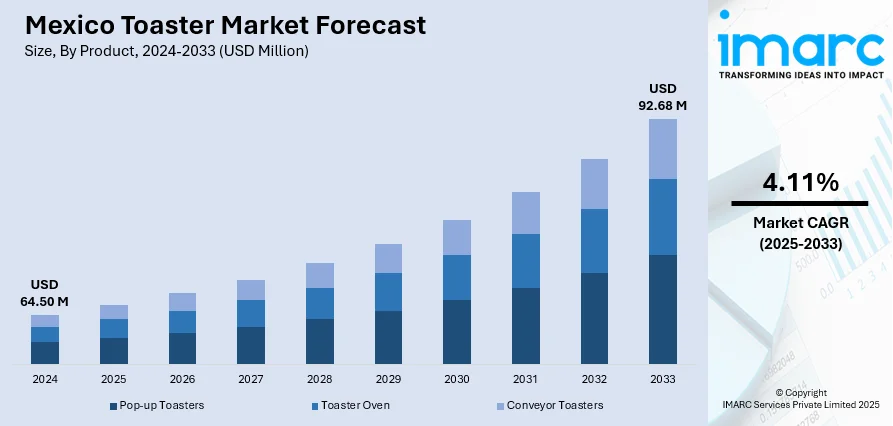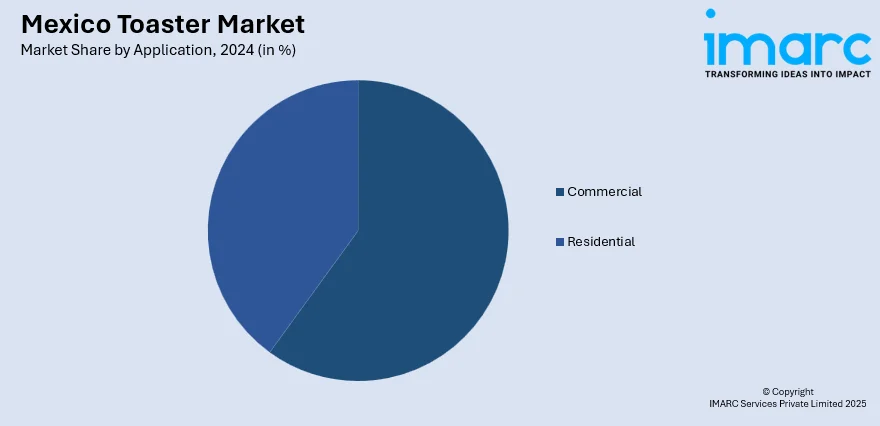
Mexico Toaster Market Size, Share, Trends and Forecast by Product, Application, Distribution Channel, and Region, 2025-2033
Mexico Toaster Market Overview:
The Mexico toaster market size reached USD 64.50 Million in 2024. Looking forward, IMARC Group expects the market to reach USD 92.68 Million by 2033, exhibiting a growth rate (CAGR) of 4.11% during 2025-2033. The market is experiencing significant growth driven by rising urbanization, changing breakfast habits, and increasing demand for compact and affordable kitchen appliances. Consumers showing interest in energy-efficient and multi-functional models, especially in metropolitan areas, along with the expansion of online retail and availability of diverse brands are further supporting the Mexico toaster market share.
|
Report Attribute
|
Key Statistics
|
|---|---|
|
Base Year
|
2024 |
|
Forecast Years
|
2025-2033
|
|
Historical Years
|
2019-2024
|
| Market Size in 2024 | USD 64.50 Million |
| Market Forecast in 2033 | USD 92.68 Million |
| Market Growth Rate 2025-2033 | 4.11% |
Mexico Toaster Market Trends:
Rising Demand for Affordable Appliances
Affordability is the key driver of buying behavior in Mexico's toaster market. Most consumers are very price-sensitive, which means great demand for cheap toasters with basic features such as easy toasting, control over browning, and sleek styling. Such toasters appeal to first-time buyers, students, and lower- to middle-income households that want efficient kitchen appliances without sky-high prices. Producers are responding by introducing low-cost models that achieve a compromise between performance and reliability, usually focused on uncomplicated mechanical designs to reduce the cost of production. Local manufacturers, in particular, are gaining popularity by offering competitive prices and low-cost after-sales service. The products are also promoted by sellers through frequent discounts and value packs, mainly in hypermarkets and online platforms. This price-based demand continues to drive product innovation and market forces in Mexican urban and semi-urban areas.

Growing Preference for Energy Efficiency
Energy efficiency has become an important consideration for consumers in Mexico, particularly in urban areas where electricity costs are rising, and environmental awareness is increasing. Households are now looking for toasters that consume less power while maintaining reliable performance. Manufacturers are addressing this demand by developing models with faster heating elements, auto shut-off features, and insulated exteriors that help retain heat and reduce energy use. These innovations are being incorporated even into lower-priced models to appeal to budget-conscious buyers who also value sustainability. Energy labels and product comparisons based on power consumption are influencing buying decisions both in-store and online. As consumers prioritize appliances that support long-term cost savings, energy-efficient toasters are gaining significant traction. This trend is contributing to Mexico toaster market growth, with manufacturers aligning product design and marketing strategies to highlight reduced energy consumption and cost-effectiveness.
Growth of E-commerce Channels
The rise of e-commerce platforms in Mexico is significantly reshaping how consumers purchase kitchen appliances, including toasters. Online marketplaces such as Amazon, Walmart, and Mercado Libre offer a wide selection of brands, models, and price points, making it easier for buyers to compare features and find the best deals. The convenience of home delivery, flexible payment options, and frequent promotional campaigns are attracting a growing number of consumers, particularly in urban and semi-urban areas. Product reviews, ratings, and detailed descriptions help buyers make informed decisions, increasing trust in online shopping. Smaller brands are also leveraging digital platforms to reach new customer segments without the overhead costs of physical retail. This shift toward online purchasing is reducing regional access gaps and encouraging product experimentation among consumers. The expansion of digital retail is thus playing a pivotal role in driving Mexico toaster market growth.
Mexico Toaster Market Segmentation:
IMARC Group provides an analysis of the key trends in each segment of the market, along with forecasts at the country and regional levels for 2025-2033. Our report has categorized the market based on product, application, and distribution channel.
Product Insights:
- Pop-up Toasters
- Toaster Oven
- Conveyor Toasters
The report has provided a detailed breakup and analysis of the market based on the product. This includes pop-up toasters, toaster oven, and conveyor toasters.
Application Insights:

- Commercial
- Residential
A detailed breakup and analysis of the market based on the application have also been provided in the report. This includes commercial and residential.
Distribution Channel Insights:
- Offline
- Online
A detailed breakup and analysis of the market based on the distribution channel have also been provided in the report. This includes offline and online.
Regional Insights:
- Northern Mexico
- Central Mexico
- Southern Mexico
- Others
The report has also provided a comprehensive analysis of all the major regional markets, which include Northern Mexico, Central Mexico, Southern Mexico, and Others.
Competitive Landscape:
The market research report has also provided a comprehensive analysis of the competitive landscape. Competitive analysis such as market structure, key player positioning, top winning strategies, competitive dashboard, and company evaluation quadrant has been covered in the report. Also, detailed profiles of all major companies have been provided.
Mexico Toaster Market Report Coverage:
| Report Features | Details |
|---|---|
| Base Year of the Analysis | 2024 |
| Historical Period | 2019-2024 |
| Forecast Period | 2025-2033 |
| Units | Million USD |
| Scope of the Report |
Exploration of Historical Trends and Market Outlook, Industry Catalysts and Challenges, Segment-Wise Historical and Future Market Assessment:
|
| Products Covered | Pop-up Toasters, Toaster Oven, Conveyor Toasters |
| Applications Covered | Commercial, Residential |
| Distribution Channels Covered | Offline, Online |
| Regions Covered | Northern Mexico, Central Mexico, Southern Mexico, Others |
| Customization Scope | 10% Free Customization |
| Post-Sale Analyst Support | 10-12 Weeks |
| Delivery Format | PDF and Excel through Email (We can also provide the editable version of the report in PPT/Word format on special request) |
Key Questions Answered in This Report:
- How has the Mexico toaster market performed so far and how will it perform in the coming years?
- What is the breakup of the Mexico toaster market on the basis of product?
- What is the breakup of the Mexico toaster market on the basis of application?
- What is the breakup of the Mexico toaster market on the basis of distribution channel?
- What is the breakup of the Mexico toaster market on the basis of region?
- What are the various stages in the value chain of the Mexico toaster market?
- What are the key driving factors and challenges in the Mexico toaster market?
- What is the structure of the Mexico toaster market and who are the key players?
- What is the degree of competition in the Mexico toaster market?
Key Benefits for Stakeholders:
- IMARC’s industry report offers a comprehensive quantitative analysis of various market segments, historical and current market trends, market forecasts, and dynamics of the Mexico toaster market from 2019-2033.
- The research report provides the latest information on the market drivers, challenges, and opportunities in the Mexico toaster market.
- Porter's five forces analysis assist stakeholders in assessing the impact of new entrants, competitive rivalry, supplier power, buyer power, and the threat of substitution. It helps stakeholders to analyze the level of competition within the Mexico toaster industry and its attractiveness.
- Competitive landscape allows stakeholders to understand their competitive environment and provides an insight into the current positions of key players in the market.
Need more help?
- Speak to our experienced analysts for insights on the current market scenarios.
- Include additional segments and countries to customize the report as per your requirement.
- Gain an unparalleled competitive advantage in your domain by understanding how to utilize the report and positively impacting your operations and revenue.
- For further assistance, please connect with our analysts.
 Request Customization
Request Customization
 Speak to an Analyst
Speak to an Analyst
 Request Brochure
Request Brochure
 Inquire Before Buying
Inquire Before Buying




.webp)




.webp)












